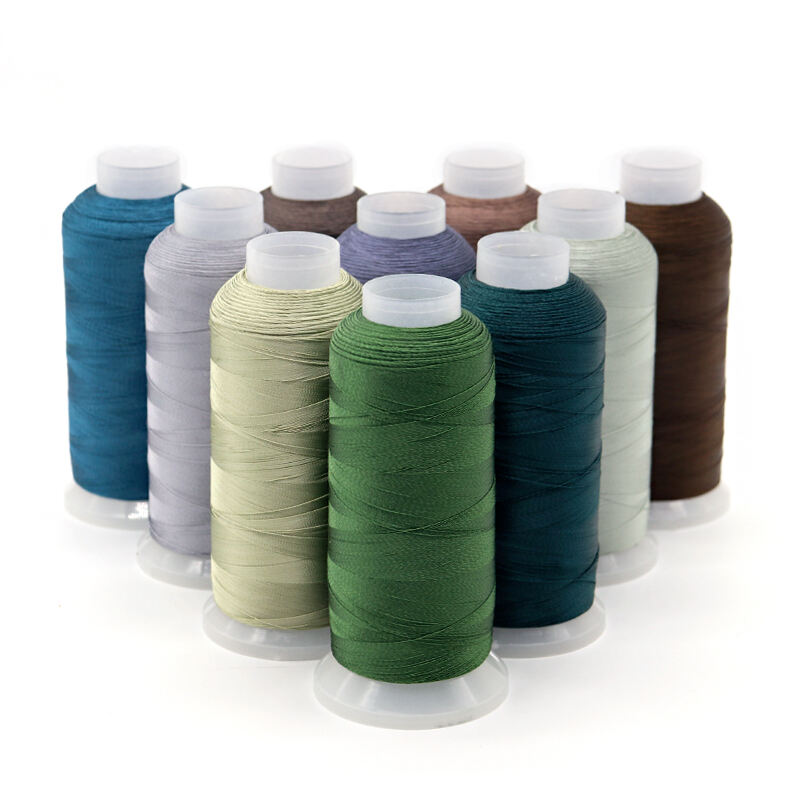The Luminous Appeal of Viscose in Modern Embroidery
In the world of decorative stitching, viscose thread has emerged as a star performer, captivating artisans and crafters with its distinctive sheen and versatile properties. This remarkable textile innovation combines the best of natural and manufactured materials, offering a lustrous finish that transforms ordinary embroidery into extraordinary artwork. The unique characteristics of viscose thread have made it an indispensable component in both hand embroidery and machine stitching, revolutionizing the way we approach decorative needlework.
The allure of viscose thread lies in its ability to reflect light in a way that creates depth and dimension in embroidered designs. Unlike conventional threads, viscose captures and plays with light, producing an almost silk-like radiance that enhances every stitch. This inherent luminosity has made it a favorite among professional embroiderers and hobbyists alike, particularly when creating pieces that demand visual impact and sophisticated elegance.
Understanding Viscose Thread Composition
Manufacturing Process and Material Science
The creation of viscose thread begins with natural cellulose fibers, typically derived from wood pulp or cotton linters. These materials undergo a complex chemical process that transforms them into regenerated cellulose fibers. The resulting thread combines the strength of synthetic materials with the comfort and breathability of natural fibers. During manufacturing, the cellulose solution is extruded through tiny spinnerets, creating continuous filaments that are then twisted together to form the final thread.
The unique manufacturing process of viscose thread contributes significantly to its characteristic shine. The smooth surface of the filaments reflects light uniformly, creating that coveted lustrous appearance. Additionally, the process allows for precise control over the thread's thickness and texture, ensuring consistency in both appearance and performance.
Physical Properties and Performance Characteristics
Viscose thread possesses several distinctive physical properties that set it apart in decorative applications. Its high tensile strength enables it to withstand the rigors of both hand and machine stitching without breaking or fraying. The thread's natural elasticity allows it to move with the fabric, preventing puckering and maintaining the integrity of the design over time.
The molecular structure of viscose thread contributes to its exceptional dye absorption capabilities. This property allows for the creation of deeply saturated colors that retain their vibrancy even after repeated washing. The thread's ability to take on dye so effectively also means that manufacturers can produce an extensive range of colors, from subtle pastels to rich jewel tones.
Design Applications and Creative Possibilities
Artistic Expression in Machine Embroidery
When it comes to machine embroidery, viscose thread opens up a world of creative possibilities. Its smooth surface allows it to glide effortlessly through machine needles, reducing tension issues and thread breakage. This reliability makes it possible to create intricate designs with minimal interruption, resulting in cleaner, more professional-looking finished pieces.
The thread's natural sheen particularly excels in designs that incorporate light and shadow effects. Machine embroiderers often use viscose thread to create realistic representations of metallic objects, water surfaces, or silk fabrics. The thread's ability to catch and reflect light adds depth to these designs, making them appear more three-dimensional and lifelike.
Hand Embroidery Techniques and Effects
In hand embroidery, viscose thread offers exceptional control and manageability. Its smooth texture allows it to lie flat against the fabric, creating clean lines and even stitches. This characteristic is particularly valuable when working with traditional techniques like satin stitch or long and short stitch, where achieving a smooth surface is crucial to the overall effect.
The thread's lustrous quality adds an extra dimension to surface embroidery techniques. When used in raised work or stumpwork, viscose thread creates stunning highlights and shadows, enhancing the dimensional aspects of the design. Its versatility allows embroiderers to experiment with various techniques while maintaining consistent quality in their work.

Maintenance and Care Considerations
Proper Storage and Handling
To maintain the optimal performance of viscose thread, proper storage is essential. The thread should be kept away from direct sunlight, which can fade colors and potentially weaken the fibers. Storing spools in a clean, dry environment helps prevent dust accumulation and moisture damage. Many professional embroiderers recommend using thread organizers or boxes that protect the thread while keeping it easily accessible.
When handling viscose thread, it's important to maintain clean hands and work surfaces. The smooth surface of the thread can easily pick up oils and dirt, which may affect its performance and appearance. Using thread conditioners or lubricants specifically designed for viscose can help maintain its smooth passage through fabric and prevent static buildup.
Cleaning and Long-term Care
Embroidered items featuring viscose thread require specific care to maintain their beauty. While the thread is generally colorfast, gentle washing in cool water with mild detergent is recommended. Avoid harsh chemicals and bleaching agents, as these can damage the thread's surface and diminish its characteristic shine.
For long-term care, store completed pieces flat or rolled rather than folded to prevent creasing of the embroidery. When pressing is necessary, use a pressing cloth and iron on the reverse side of the embroidery to protect the thread's surface. These careful maintenance practices will help preserve the luminous quality of viscose thread embroidery for years to come.
Frequently Asked Questions
How does viscose thread compare to other embroidery threads in terms of durability?
Viscose thread offers excellent durability when properly maintained. While it may not be as strong as polyester or nylon threads, it provides sufficient strength for most decorative applications while offering superior shine and color absorption. With proper care, viscose thread embroidery can maintain its beauty and integrity for many years.
Can viscose thread be used in all embroidery machines?
Most modern embroidery machines are compatible with viscose thread. However, it's important to use the correct needle size and adjust tension settings appropriately. Some older machines may require specific adjustments or thread guides to accommodate viscose thread's smooth texture and prevent slipping or tangling.
What makes viscose thread particularly suitable for decorative stitching?
Viscose thread excels in decorative applications due to its natural luster, excellent color retention, and smooth texture. These properties allow for creating vibrant, eye-catching designs with a silk-like sheen that cannot be achieved with standard cotton or polyester threads. The thread's ability to reflect light and create dimensional effects makes it particularly valuable for artistic embroidery work.

